|
Lieutenant Colonel William C. Walker
Lieutenant Colonel
William Clay Walker
(August 4, 1820–January 3, 1864)
While on sick leave at home
in Murphy, Cherokee County, North Carolina, with his loving family and in hopes of recovering during the cold hour on January 3, 1864, Lt. Col. William C. Walker was awakened and murdered
by common citizens turned outlaws – miscreants and cowardly men who knew Walker from before the war and had
now used the four year conflict for their own bloodletting. The cold-blooded murder of the commanding officer of Walker's
Battalion was merely another senseless act that was born of Civil War in the rugged region known as Western North Carolina. While it was the setting of lawlessness, this was the region that became host to a war within a war, an Uncivil
War, and it was filled with such disenchanted men who had fled the Conscription Act, another term for draft, and
those of the baser sort, men who would use chaos as the ultimate diversion while they unleashed punishing blows on communities
that just a few years ago were known for being calm yet charming Southern locales.
| Walker's Battalion History |
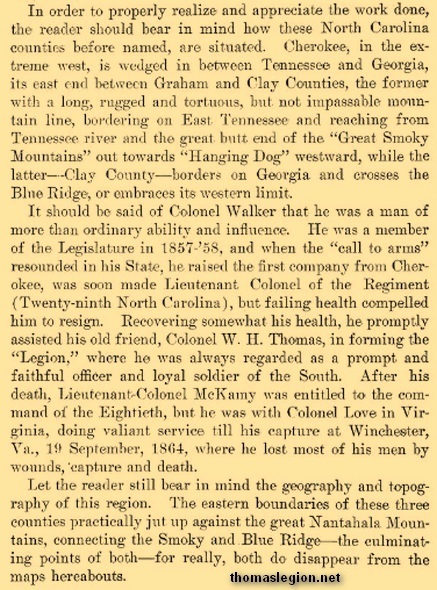
|
| Walker's Battalion, Thomas' Legion |
| Walker's Battalion |
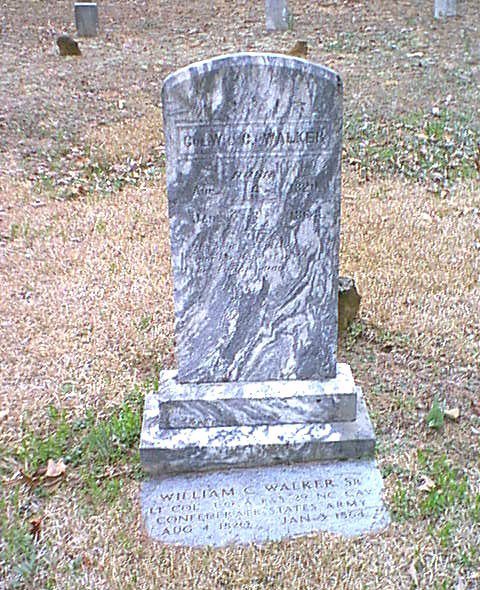
|
| William C. Walker Gravesite |
(Left) William Clay Walker grave at Walker Family Cemetery,
Panther Top Rd., Cherokee County, N.C. Photo Courtesy Carolyn Ellertson. (Right) Robert A. Aiken, former Captain of Company
H, Walker's Battalion, wrote the history, or sketch, of Walker's Battalion for Clark's Regiments in 1901. On
page 122, Aiken emphasized the enormous task assigned to the battalion as it strived to defend the great swath known
as western North Carolina. Although Walker's Battalion would remain part of the Thomas Legion and never attain regimental
status during the conflict, postwar many soldiers, including Aiken, would call it the 80th North Carolina Regiment. Clark,
Walter ed. (1901). Histories of the Several Regiments and Battalions in the Great War 1861-1865, Volume IV. Goldsboro,
North Carolina: Nash Brothers.
| William C. Walker |
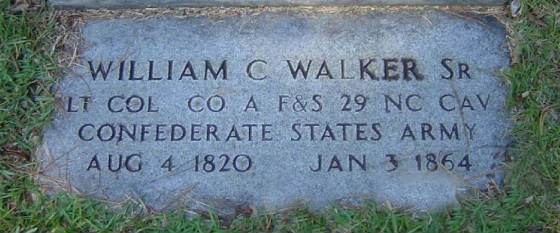
|
| William Clay Walker, Father, Husband, Friend |
While it was an era of lawlessness and of settling both old and new
feuds, many born during the conflict, the wartime tentacles would extend and result in the calculated murders of many
good folks. If battle or disease didn't kill a man, and if the soldier survived roving bushwhackers, pillaging deserters,
and blood thirsty guerrilla groups, it may have been the soft knock on the door from none other than a neighbor
who would arrive cloaked as the grim reaper himself.
Prior to hostilities, a conflict now generally known as the American Civil War or the War
of Northern Aggression, Mr. William Walker was a well-liked gentleman who had represented his constituents in the
North Carolina legislature during 1857-58. He would raise the first company of soldiers from Cherokee County before being
elected lieutenant colonel of the 29th North Carolina Troops. Whereas ailing health would soon force Walker to resign from the 29th, and though not yet fully recovered, he would promptly
assist his old friend, William Holland Thomas, in forming the Thomas Legion. War is hell, it has been coined, and Walker would
soon return to Murphy in December of 1863 with hopes of recovering from his lagging wartime health.
| History of Walker's Battalion |

|
| William C.Walker, commanding Walker's Battalion |
(Right) This final report showing Lt. Col. William C. Walker commanding the battalion on January 31, 1864, was
made in error. Maj. James A. McKamy had been temporarily commanding the battalion since September 11, 1863, but,
following Walker's death, he would assume command until his capture at the Third Battle of Winchester on September
19, 1864. And although Walker had been killed on January 3, 1864, it would not be noted until after this return dated
January 31. McKamy, subsequently promoted to lieutenant colonel, was also noted as commanding the battalion on two previous reports
dated December 31, 1863, and January 8, 1864, respectively. (Official Records, Series 1, Volume 29, part 2,
pp. 908-909; and Official Records, Series 1, Volume 32, part 2, pp. 535-536.) Notice that Thomas' Legion composed Jackson's entire brigade as stated in this January 31, 1864, return for the Organization
of troops in the Department of East Tennessee. Official Records of the Union and Confederate Armies, Series
1, Volume 32, part 2, p. 642.
His wife, Mrs. Elmira Walker, would always remember that calm and casual knock on the door just days following the ushering in of the sober New Year
of 1864. Now a widow, Walker would raise her children alone before her passing nearly 35 years later on November
4, 1898. Lt. Col. Walker's murder also
altered Col. William H. Thomas' view of the conflict and it served to reinforce his initial position and pleas
to Confederate authorities to protect and defend North Carolina's western counties. Thomas had retained the Cherokee Life Guard in part because of Walker's death, and the Indians of this formation would
remain close to him for the duration of the war.
When Walker was "shot down like a dog" during the winter
of 1863-64, according to Robert A. Aiken, the battalion historian, Thomas and the Cherokee Battalion were fighting bands
of deserters and bushwhackers in the North Carolina mountains, and Walker's Battalion was performing provost duties
while engaging guerrillas and outliers in East Tennessee. The regiment of the command would be detached
and pushed into the Shenandoah Valley in May 1864 before rejoining the Thomas Legion in Western North Carolina during
December 1864. (Official Records of the Union and Confederate Armies,
Series 1, Volume 32, part II, p. 611.) The unified organization
would end the conflict after its final action against Union troops in May 1865.
It has been said that when a man is under immense pressure, that is when you really find out the character of
a man, that is when you actually find out what a man is made of. While many in these parts would be seen under pressure
by lending helping hands to hurting hearts, there was the fraction that openly extravasated raw hatred
toward their fellow man. The war had brought out the best and it had brought out the worst in everyone. See also Shelton Laurel
Massacre, O.R., IV,
pt. 2, pp. 732-734, O.R., 1, 53, pp. 324-336, O.R., 1, 32, pt.
II, pp. 610-611.
| Map of Cherokee County, North Carolina |
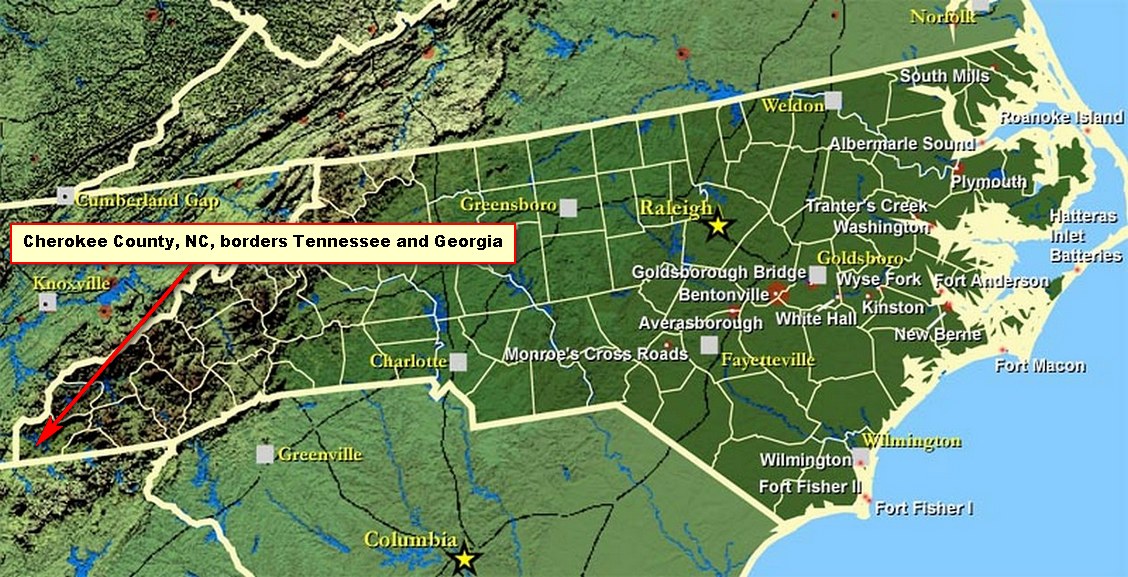
|
| High Resolution Map of Cherokee County, North Carolina |
| 80th North Carolina Regiment |
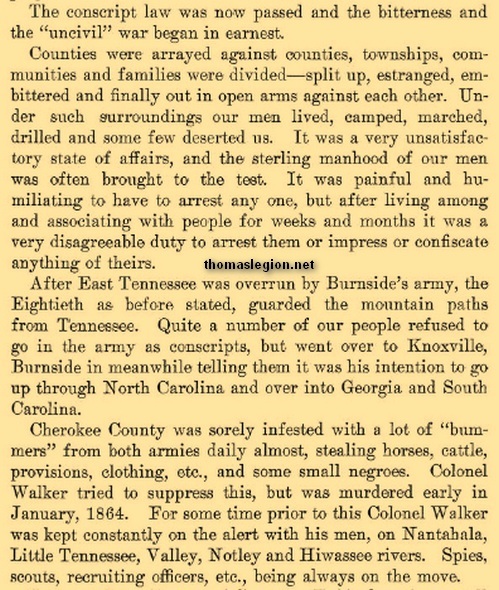
|
| Walker's Battalion |
(Right) Robert A. Aiken, page 125 of Clark's Regiments,
stated that after Confederate conscription passed, it created an atmosphere which he referred to as uncivil
war.
William C. Walker, commanding, July 18, 1862–September
11, 1863*
Officially organized on July, 18, 1862, when Stringfield mustered
its first company in Cherokee County, North Carolina. During July and August, the Battalion comprised the companies of Berry,
Walker, Parker, and Cooper. Six companies were added in September but Parker and Cooper
were transferred to the Regiment, Thomas' Legion. On October 1, the Battalion, 600 officers and men, was mustered at
Knoxville, and William C. Walker was selected as Lieutenant Colonel. By the end of October 1862 the ranks increased to a total
of 740 men. James A. McKamy was promoted to Major in August 1863 and assumed command of the Battalion, which was reduced to
500 men in September 1863. After Walker's death in January 1864, McKamy was promoted
to Lieutenant Colonel. After McKamy's capture at the Third Battle of Winchester (Virginia)
on September 19, 1864, during General Early's Valley Campaign, Lieutenant James A. Robinson led a portion
of the Battalion during the remainder of the Valley Campaign and until it returned to North Carolina in December 1864.
In February 1865, General James Green Martin officially placed Stringfield in command of the Battalion, but Captain Stephen Whitaker would lead the unit at the
end of the war. The Battalion was known as Walker's Battalion, McKamy's Battalion and at times simply as Battalion. When
Thomas officially organized the Indian Battalion at the end of the war, Walker's Battalion became known as First Battalion,
with the Cherokee Battalion referred to as Second Battalion.
When the unit mustered at Knoxville it had 7 companies, including 3 of Tennessee cavalry. The
mounted units were all transferred from the Battalion in December 1862, so that during most of the unit's service it
only had 5 infantry companies.
The arduous service of this battalion was summarized by its historian Captain Robert A. Aiken.
Immediately after its organization, Aiken recorded, Walker's Battalion
was "scattered along the Bristol and Chattanooga Railroad," guarding bridges, depots and block houses, towns and communities.
The unit was "also arresting conscripts, deserters, and doing other provost duties," said Aiken. "The four counties
of Cherokee, Clay, Graham, and Swain, were disputed territory all this time." Aiken reported that "while large bodies of Federals
seldom came out, yet small scouts were constantly depredating upon and killing the citizens and taking off many to prison.
Colonel Walker was murdered at his home near Murphy on the night of 3 January, 1864, while there on sick leave." Aiken affirmed
that "Cherokee County was sorely infested with a lot of 'bummers' from both armies daily almost, stealing horses, cattle,
provisions, clothing, etc., and some small negroes. Colonel Walker tried to suppress this, but was murdered early in January,
1864." The men of this battalion would be numbered among the last to surrender East of the Mississippi. On May 14,
1865, and more than a month after Lee had surrendered to Grant, Maj. Stephen Whitaker and battalion would surrender and be
paroled in Franklin, N.C. See also The Last Shot of the American Civil War.
*Lt.
Col. William C. Walker commanded Walker's Battalion of the Thomas Legion, and his command was referred to by many who filled its ranks as the 80th North Carolina Regiment,
but it was never officially recognized as the 80th nor did the unit ever meet regimental strength. While some of its men
did believe that the battalion at one time hosted regimental numbers, it remains a mystery as to why, because once
the mounted units were transferred in late '62, its rosters began to thin as attrition took its course. Others perhaps
thought that it was going to be increased to a regiment, but absent any official writings to corroborate either, it remains
a battalion. Following the war, many a veteran turned author would write showing the unit as the 80th,
but they too were writing more on hearsay than fact.
**Lt. Col. McKamy commanded the battalion following the death of Lt.
Col. Walker, but when McKamy was captured at 3rd Winchester, Lt James A. Robinson assumed command of the Battalion for the remainder of the Shenandoah Valley Campaign, from September 19, 1864 until its return to North Carolina with Special Order
267. Lt. Col. William Stringfield would then assume commandership, with Captain
Whitaker leading the unit at war's end.
(Sources and Related Reading listed below.)
Recommended
Reading: Storm in the Mountains: Thomas' Confederate Legion of Cherokee Indians and Mountaineers (Thomas' Legion: The
Sixty-ninth North Carolina Regiment). Description: Vernon H. Crow, Storm in the Mountains,
dedicated an unprecedented 10 years of his life to this first yet detailed history of the Thomas Legion. But
it must be said that this priceless addition has placed into our hands the rich story of an otherwise forgotten era of
the Eastern Cherokee Indians and the mountain men of both East Tennessee and western North Carolina who would fill the
ranks of the Thomas Legion during the four year Civil War. Crow sought out every available primary and secondary source by traveling to several states
and visiting from ancestors of the Thomas Legion to special collections, libraries, universities, museums, including
the Museum of the Cherokee, to various state archives and a host of other locales for any material on the unit in
order to preserve and present the most accurate and thorough record of the legion. Crow, during his exhaustive fact-finding, was
granted access to rare manuscripts, special collections, privately held diaries, and never before seen nor published photos
and facts of this only legion from North Carolina. Crow remains absent from the text as he gives a readable
account of each unit within the legion's organization, and he includes a full-length roster detailing each of the men who
served in its ranks, including dates of service to some interesting lesser known facts.
Storm in the Mountains, Thomas' Confederate Legion of Cherokee Indians and
Mountaineers is presented in a readable manner that is attractive to any student and reader of American history, Civil
War, North Carolina studies, Cherokee Indians, ideologies and sectionalism, and I would be remiss without including the
lay and professional genealogist since the work contains facts from ancestors, including grandchildren, some of which
Crow spent days and overnights with, that further complement the legion's roster with the many names,
dates, commendations, transfers, battle reports, with those wounded, captured, and killed, to lesser yet
interesting facts for some of the men. Crow was motivated with the desire to preserve
history that had long since been overlooked and forgotten and by each passing decade it only sank deeper into the annals
of obscurity. Crow had spent and dedicated a 10 year span of his life to
full-time research of the Thomas Legion, and this fine work discusses much more than the unit's formation, its
Cherokee Indians, fighting history, and staff member narratives, including the legion's commander, Cherokee chief and
Confederate colonel, William Holland Thomas. Numerous maps and
photos also allow the reader to better understand and relate to the subjects. Storm in the Mountains, Thomas' Confederate Legion of Cherokee Indians and Mountaineers is
highly commended, absolutely recommended, and to think that over the span of a decade Crow, for us, would meticulously
research the unit and present the most factual and precise story of the men, the soldiers who formed, served, and died
in the famed Thomas Legion.
Recommended Reading: North Carolina Troops, 1861-1865: A Roster
(Volume XVI: Thomas's Legion) (Hardcover, 537 pages), North Carolina Office of Archives and History. Description: The
volume begins with an authoritative 246-page history of Thomas's Legion. The history, including Civil War battles and campaigns, is
followed by a complete roster and service records of the field officers, staff, and troops that served in the legion. A thorough
index completes the volume. Continued...
Volume XVI
of North Carolina Troops: A Roster contains the history and roster of the most unusual North Carolina Confederate Civil
War unit, significant because of the large number of Cherokee Indians who served in its ranks. Thomas's Legion was the creation
of William Holland Thomas, an influential businessman, state legislator, and Cherokee chief. He initially raised a small
battalion of Cherokees in April 1862, and gradually expanded his command with companies of white soldiers raised in western
North Carolina,
eastern Tennessee, and Virginia.
By the end of 1862, Thomas's Legion comprised an infantry regiment and a battalion of infantry and cavalry. An artillery battery
was added in April 1863. Furthermore, in General Early's Army of the Valley, the Thomas Legion was well-known for its fighting
prowess. It is also known for its pivotal role in the last Civil War battle east of the Mississippi
River. The Thomas Legion mustered more than 2,500 soldiers and it closely resembled a brigade. With troop roster, muster records, and Compiled Military Service Records (CMSR) this volume
is also a must have for anyone interested in genealogy and researching Civil War ancestors. Simply stated, it is an outstanding
source for genealogists.
Walker Genealogy:
Recommended Reading:
Bushwhackers, The Civil War in North Carolina: The Mountains
(338 pages). Description: Trotter's book (which could
have been titled "Murder, Mayhem, and Mountain Madness") is an epic backdrop for the most horrific murdering, plundering
and pillaging of the mountain communities of western North Carolina during the state’s darkest hour—the American
Civil War. Commonly referred to as Southern Appalachia, the North Carolina and East Tennessee mountains witnessed divided loyalties in its bushwhackers and guerrilla units. These
so-called “bushwhackers” even used the conflict to settle old feuds and scores, which, in some cases, continued
well after the war ended. Continued below.
Some bushwhackers
were highly organized ‘fighting guerrilla units’ while others were a motley group of deserters and outliers,
and, since most of them were residents of the region, they were familiar with the terrain and made for a “very formidable
foe.” In this work, Trotter does a great job on covering the many facets of the bushwhackers, including their: battles,
skirmishes, raids, activities, motives, the outcome, and even the aftermath. This book is also a great source for tracing
ancestors during the Civil War; a must have for the family researcher of Southern Appalachia.
Recommended Reading: Hardtack &
Coffee or The Unwritten Story of Army Life. Description: Most histories of the Civil War focus on battles
and top brass. Hardtack and Coffee is one of the few to give a vivid, detailed picture of what ordinary soldiers endured every
day—in camp, on the march, at the edge of a booming, smoking hell. John D. Billings of Massachusetts
enlisted in the Army of the Potomac and survived the hellish conditions as a “common
foot soldier” of the American Civil War. "Billings
describes an insightful account of the conflict – the experiences of every day life as a common foot-soldier –
and a view of the war that is sure to score with every buff." Continued below...
The
authenticity of his book is heightened by the many drawings that a comrade, Charles W. Reed, made while in the field. This
is the story of how the Civil War soldier was recruited, provisioned, and disciplined. Described here are the types of men
found in any outfit; their not very uniform uniforms; crowded tents and makeshift shelters; difficulties in keeping clean,
warm, and dry; their pleasure in a cup of coffee; food rations, dominated by salt pork and the versatile cracker or hardtack;
their brave pastimes in the face of death; punishments for various offenses; treatment in sick bay; firearms and signals and
modes of transportation. Comprehensive and anecdotal, Hardtack and Coffee is striking for the pulse of life that runs through
it.
Sources:
National Archives and Records Administration; Walker's Service Record; Stringfield's Service Record; McKamy's
Service Record; Parker's Service Record; Robinson's Service Record; W. H. Thomas's Service Record; Moore's
Roster; Hunter Library, Western Carolina University; Official Records of the Union and Confederate Armies; Vernon H. Crow, Storm in the Mountains: Thomas'
Confederate Legion of Cherokee Indians and Mountaineers; Walter Clark, Histories of the Several Regiments and Battalions from
North Carolina in the Great War 1861-1865; National Park Service: American Civil War; Weymouth T. Jordan and Louis H.
Manarin, North Carolina Troops, 1861-1865; D. H. Hill, Confederate Military History Of North Carolina: North Carolina
In The Civil War, 1861-1865; Christopher M. Watford, The Civil War in North Carolina: Soldiers' and Civilians' Letters
and Diaries, 1861-1865. Volume 2: The Mountains; Library of Congress; National Archives and Records Administration; State
Library of North Carolina; North Carolina Office of Archives and History; North Carolina Museum of History; E. Stanly
Godbolt, Jr. and Mattie U. Russell, Confederate Colonel and Cherokee Chief: The Life of William Holland Thomas; Paul A. Thomsen, Rebel Chief: The Motley Life of Colonel William Holland Thomas C.S.A.
|

